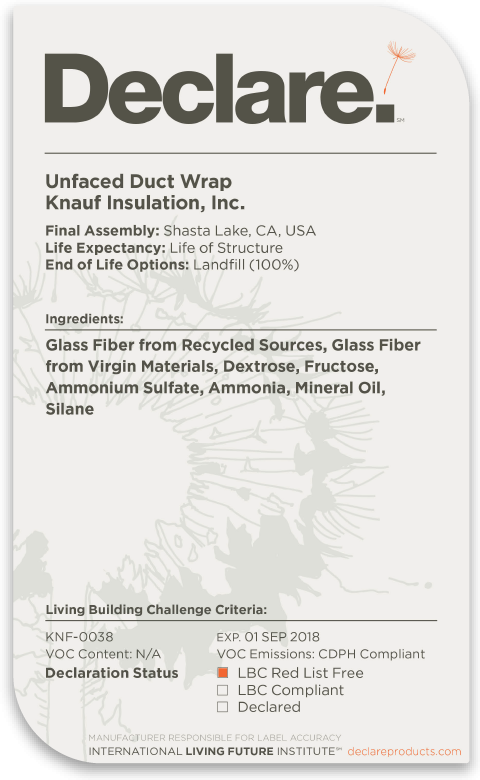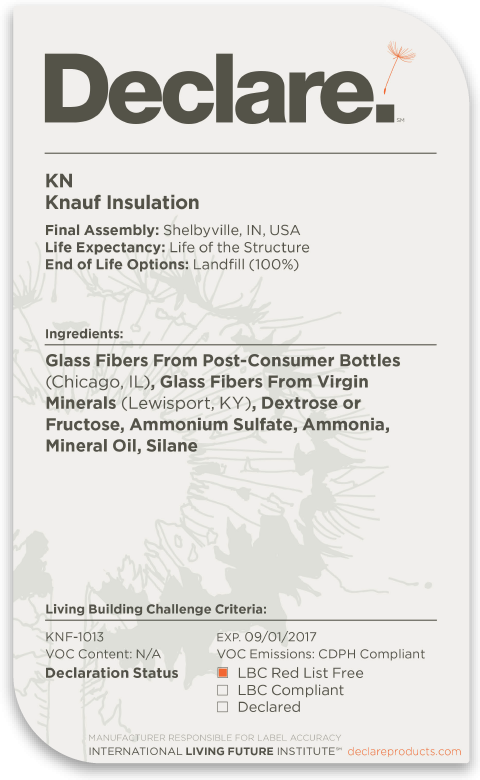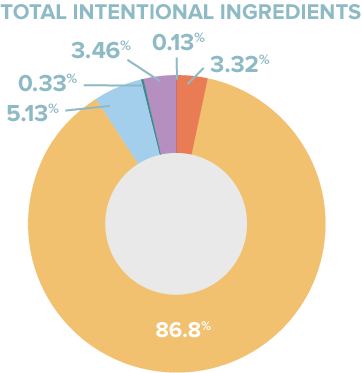LCA & material health results & interpretation Atmosphere™ Duct Wrap & KN Series
Evaluation programs
Declare
Declare labels are issued to products disclosing ingredient inventory, sourcing and end of life options. Declare labels are based on the Manufacturers Guide to Declare, administered by the International Living Future Institute.
How it works
Material ingredients are inventoried and screened against the Living Building Challenge (LBC) Red List which represents the ‘worst in class’ materials, chemicals, and elements known to pose serious risks to human health and the greater ecosystem.
The Health Product Declaration®
The HPD Open Standard provides a consistent, and transparent format to accurately disclose the material contents and associated hazard classifications for a building product.
How it works
Material ingredients are screened and categorized according to the hazards that international governmental bodies and toxicology experts have associated with them, based on two listings:
- Authoritative lists maintained or recognized by government bodies
- Screening lists, which include chemicals that government bodies determined need further scrutiny, as well as chemical lists not recognized by any government body.
Assessment scope and results
Declare™
Inventory threshold: 100 ppm
Declare level:
The Declare product database and label are used to select products that meet the LBC's stringent materials requirements, streamlining the materials specification and certification process.
Click the label to see the full declaration.
Unfaced Duct Wrap |
KN Insulation |
|---|---|

|

|
What's in this product and why
Declare level
The base fibers of both Atmosphere™ Duct Wrap and KN Utility Insulation have no Red List chemicals. The Red List is a list of chemicals that are not allowed in Living Building Challenge buildings. Being Red List free is our design benchmark at Knauf.
Because of stringent fire performance requirements for this class of product, fire retardants are used in the foil scrim kraft (FSK) product variant. Those fire retardants are on the Red List. A health product declaration (HPD) is provided for the FSK variant.
What's in the product and why
The ingredients of the unfaced variants avoid the 800+ chemicals of the Living Building Challenge Red List. This is primarily because of its bio-based binder adhesive chemistry known as ECOSE® Technology. ECOSE is based on dextrose or high fructose corn syrup instead of phenol and formaldehyde. Dextrose and fructose can be used interchangeably. The ECOSE binder allows the product to be validated by the UL Environment as formaldehyde-free. Formaldehyde is a Red List chemical.
Atmosphere Duct Wrap with the FSK facer does not meet Red List free status because the facer contains a halogenated fire retardant (HFR). This is why we disclose the ingredients as an HPD rather than Declare used for all other product variants.
Red List free is our development benchmark and we constantly challenge ourselves on elimination of Red List chemicals. An HFR is used on the FSK variant because the product is for exposed applications and must meet stringent fire performance requirements. We are very aware of the concerns associated with HFRs and continually work with vendors on this issue. At the same time, fire performance is critical and current events relating to fire performance of building materials only support the importance of fire-safe products.
What's been done in the design and manufacture in consideration of the potential human health impacts in the use stage
Knauf led the industry in bio-based development to avoid phenol and formaldehyde in our processes beginning in 2008. This development was likely the largest green chemistry disruption of our era. Today, our competitors have followed or are striving to meet this benchmark.
The primary ingredient in this product is recycled glass. While recycled content may vary from year to year, the recycled content is currently greater than 60% by weight. The second largest content is silica sand which is sourced as locally as possible. The third largest ingredient is corn-based syrup (dextrose or fructose). As a result of using plant-based binders, the VOC profile of this product is very interior friendly.
The emission from our factories is also much better for our communities. We ensure our glass formulations have no serious health concerns by allowing our processes to be audited to meet European Certification Board for Mineral Wool Products (EUCEB) biosolubility requirements.
Where it goes at the end of its life
At this time, the product is landfilled at end of life. We take extended producer responsibility very seriously and have active programs to address end of life. There is no option other than landfills at this time.
How we're making it healthier
Knauf engages very closely with its vendors to eliminate and avoid chemicals of concern. No competitor has as many Red List free products as Knauf Insulation. We continually reduce our environmental impacts through recycled content and optimize our products by designing them to be transformative.
See how we make it greenerReferences
Declare
UnfacedDuct Wrap
KN Insulation
Manufacturer's Guide to Declare
A comprehensive guide providing information about the program, the assessment
methodology, how to submit material data to obtain a Declare label and how they
are used to meet the Health & Happiness and Materials Petals of the Living
Building Challenge.
Health Product Declaration®
AmtmosphereDuct Wrap with FSK Facer
Health Product Declaration Open Standard v2.1 The standard provides guidance to accurately disclose the material contents of a building product using a standard, consistent, and transparent format.
Log into your Project Library
${ loginErrorMessage }
Create my SM Transparency Catalog Project Library
You can save projects, download project packages, get spec help and request a quote.
Create my Project LibraryCreate my SM Transparency Catalog Project Library
You can save projects, download project packages, get spec help and request a quote.
We will never sell, loan, rent, trade, exchange, or share your name or your email with anyone.
Read our privacy policy.


 SM Transparency Report (EPD)
SM Transparency Report (EPD) 
